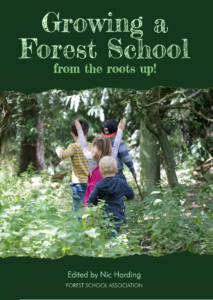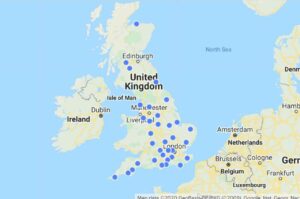 One of our most familiar evergreen natives, commonly found as an
One of our most familiar evergreen natives, commonly found as an understorey species (particularly in Oak and Beech woodland). Holly is dioecious meaning it has separate male and female trees. Only female trees have the bright red berries, a beloved food to hungry birds (particularly the mistle thrushes that have been known to guard them enthusiastically from other birds!(1)).
understorey species (particularly in Oak and Beech woodland). Holly is dioecious meaning it has separate male and female trees. Only female trees have the bright red berries, a beloved food to hungry birds (particularly the mistle thrushes that have been known to guard them enthusiastically from other birds!(1)).
Other Names: Hulver, Holm, Hollin (2)
Tree Ogham: Tinne (July 18th – August 4th)
Height: Small tree or shrub, usually 3-15m, rarely to 20m (3)
Leaf Properties & Uses: The characteristic dark green, waxy, spiky holly leaf is a seasonal symbol of winter festivals. However the leaves of older trees and those levels growing higher on the tree (above the threat from grazing animals) tend to be less prickly, in fact can be pretty much smooth edged apart from a point at its tip. Traditionally the spiky leaves were called ‘he-holly’ and the smooth ones ‘she-holly’ (4).
Holly has been/is used as an effective stockproof hedgerow species (also good for stopping witches running along the tops of hedges, apparently (2) …. personally I’ve been perplexed as to why the witches are into hedge-top running… why don’t they use their brooms!?) and also to mark boundaries. Being evergreen you can see its silhouette at a distance all year round.
The word ‘Hollin’ refers to a grove of Hollies that was traditionally pollarded to feed the ‘she-holly’ to livestock in winter. Its leaves have one of the highest calorific content of any tree browsed by animals and are rich in nutrients (2).
The use of evergreen plants, including holly, to decorate houses during midwinter festivals long pre-dates Christian traditions. The enduring growth and colour of the evergreen plants whilst all others seem to be dead or dormant means they are regarded as symbolise of the continuity of life and hope through the dark season (2).


Flowers: Small (6-8 mm) white 4 petaled flowers appear generally May – August. Male flowers have 4 stamens, female 4 carpels (3)
Fruit: Characteristic bright red, 4 seeded berries(6-8mm) on female trees only. Berries are of ‘low toxicity’ (5)
Bark: Smooth, silve ry grey often with white & dark markings. Often may have raised circular bumps, that look a bit like belly buttons (out-y’s obviously, not in-y’s!).
ry grey often with white & dark markings. Often may have raised circular bumps, that look a bit like belly buttons (out-y’s obviously, not in-y’s!).
Wood Properties & Uses: Holly wood is pale, finely grained, hard and dense. It can be complete pig to split and difficult to dry effectively (tends to
distort and split). Its fine grain makes it polish well and pale colour accepts dyes and stains readily.
Historically Holly has been used to make lace bobbin, engravers blocks, chessmen, inlay work, stocks for horse whips and sometimes dyed black as an ebony substitute. Today it is still sometimes used for inlay on decoration on furniture (6).
Holly as a firewood is ‘good when well seasoned’ (6). The dense sheltered canopies of a holly tree is a great place to find the fine kindling for campfires as handing deadwood, particularly on a rainy day! The thin ends of dangly holly twigs often die under the shade of its own canopy and I have used these successfully many times. The logs to burn poem says ‘Holly logs will burn like wax, you should burn them green’….. I’ve not tried to burn it green before…but it sounds fairly optimistic to me!
Ecology: The cascading growth habit of Holly provides dense, dry cover and good nesting opportunities for birds. Its flowers provide nectar for bees and other pollinating insects. The leaves, berries and flower buds are food for the caterpillar of the Holly Blue Butterfly (find out more about the Holly Blue on Butterfly Conservations website here). Holly berries are a winter food source for birds and small mammals (1)
Pests: A common pest associated with Holly is the ‘Holly Leaf Miner’. This is the larval stage of a fly, Phytomyzza ilicis that ‘mines’ through the leaf’s soft tissue. This appears on the leaf as patches of lines of discolouration (1).
Folklore: Holly like other evergreens represents; immortality, the tenacity of life and the cycles of growth, death and rebirth.
 Holly represents the waning half of the year. The Holly king is locked into an eternal battle with the Oak king in an endless cycle of growth, death and rebirth. At winter solstice (21st – 22nd December) Holly sacrifices himself and loses the fight with Oak, so that light and warmth may return to the land. This ancient story is echoed in the Arthurian legend of Sir Gawain and the Green Knight. The Green Knight bears a bough of holly and Gawain a club of Oak.
Holly represents the waning half of the year. The Holly king is locked into an eternal battle with the Oak king in an endless cycle of growth, death and rebirth. At winter solstice (21st – 22nd December) Holly sacrifices himself and loses the fight with Oak, so that light and warmth may return to the land. This ancient story is echoed in the Arthurian legend of Sir Gawain and the Green Knight. The Green Knight bears a bough of holly and Gawain a club of Oak.
Holly is protective and been traditionally carried as a charm against; evil spirits, poisons, angry elementals and lightning (4).
On an emotional level, Holly represents unconditional love and reminds us to calm our emotions (smooth out our prickly bits) in order to reach wise decisions.
Activity – Make a festive evergreen wreath
References:
- The Woodland Trust. (No Date) Holly (Ilex Aquifolium). Available at: woodlandtrust.org.uk/visiting-woods/trees-woods-and-wildlife/british-trees/native-trees/holly/ (Accessed: 2.12.15)
- Mabey, R. (1996) Flora Britannica. The definitive guide to wild flowers, plants and trees. Chatto & Windus
- Rose, F. (1981) The Wild Flower Key. British Isles – N.W. Europe. Fredrick Warne
- Paterson, J. (1998) A Tree in your Pocket. Thorsons
- Dauncey, E. (2010) Poisonous Plants. A guide for parents & childcare providers. Kew Publishing
- Warren, P. (2006) British Native Trees. Their past and present uses.




